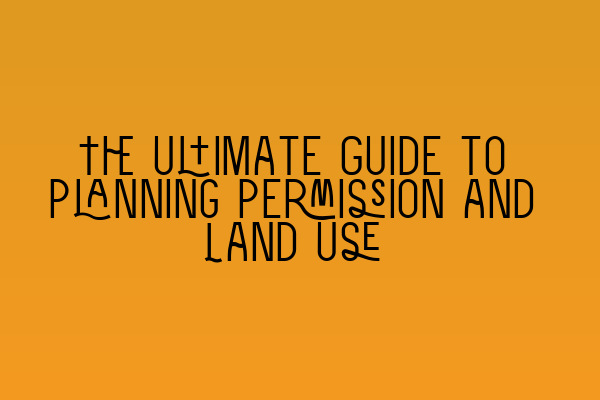The Ultimate Guide to Planning Permission and Land Use
Welcome to SQE Property Law & Land Law’s ultimate guide to planning permission and land use. In this comprehensive guide, we will walk you through everything you need to know about planning permission and how it relates to land use. Whether you are a property owner, developer, or simply interested in the topic, this guide will provide you with valuable insights and guidance.
Section 1: Understanding Planning Permission
Planning permission is a legal requirement that must be obtained from the local planning authority before any new development can take place on a piece of land. It ensures that the proposed development is in line with the local development plan and adheres to various regulations and policies set by the government.
Obtaining planning permission can be a complex process, involving the submission of detailed plans and supporting documents. It is essential to understand the key factors that influence planning permission decisions:
1. Local Development Plan
The local development plan outlines the vision and objectives for the local area’s development. It includes policies and guidelines that determine how land can be used and what types of developments are permitted. Familiarize yourself with the local development plan to understand the requirements and constraints that may affect your planning application.
2. Permitted Development Rights
Permitted development rights allow certain types of development without the need for planning permission. These rights differ depending on the location, type of property, and specific circumstances. Understanding permitted development rights can save time and money, as some projects may not require a full planning application.
If you are uncertain about permitted development rights, consult with a legal professional to ensure compliance and avoid unnecessary delays.
3. Design and Environmental Considerations
Design and environmental considerations play a crucial role in the planning permission process. The local planning authority will assess the impact of the proposed development on the surrounding area, including factors such as landscape, heritage, traffic, and infrastructure.
It is important to present a well-designed and environmentally conscious proposal to increase the chances of obtaining planning permission. Consider engaging architects, surveyors, and other professionals to assist with the preparation of your planning application.
Section 2: Applying for Planning Permission
Now that you understand the key factors that influence planning permission decisions, let’s walk through the process of applying for planning permission:
1. Pre-Application Research
Before submitting a planning application, conduct thorough research to understand the local planning policies, constraints, and requirements. This will help you prepare a robust application that addresses any potential issues upfront.
Review the local development plan and consult with professionals familiar with the local area to gain valuable insights.
2. Prepare and Submit the Planning Application
Once you have gathered all the necessary information and prepared the required documents, submit your planning application to the local planning authority. Ensure that you include all the relevant plans, drawings, and supporting documents to support your proposal.
It is advisable to use the services of an experienced planning consultant or solicitor to guide you through the application process, increasing your chances of success.
3. Application Assessment and Determination
Once your planning application has been submitted, the local planning authority will assess it based on various factors, including local policies, regulations, and public consultations. The application will be evaluated against the relevant criteria, and a decision will be made within a specified timeframe.
During this period, the local planning authority may request additional information or seek clarification on certain aspects of your proposal. It is essential to respond promptly and cooperate with any requests to avoid unnecessary delays.
Section 3: Appealing a Planning Decision
If your planning application is refused, you have the option to appeal the decision. Here are the steps involved in appealing a planning decision:
1. Review the Decision Notice
Carefully review the decision notice issued by the local planning authority, as it will outline the reasons for refusal. Understanding the grounds on which the decision was made will help you determine the best course of action.
2. Seek Professional Advice
Consult with a solicitor or planning consultant who specializes in planning appeals. They will review your case, assess its merits, and provide guidance on the best approach.
3. Prepare and Lodge the Appeal
Based on the advice received, prepare and lodge the appeal within the specified timeframe. Ensure that you provide strong supporting evidence and valid grounds for challenging the decision.
The appeal will be reviewed by the Planning Inspectorate, an independent body responsible for making planning appeal decisions. They will consider the planning merits, policy, and relevant legislation before reaching a decision.
Section 4: Conclusion
Planning permission is a crucial aspect of any development project. Understanding the intricacies of the planning permission process and how it relates to land use is essential for successful and compliant development.
If you require further guidance or legal assistance with planning permission matters, SQE Property Law & Land Law is here to help. We offer comprehensive preparation courses for the SQE 1 and SQE 2 exams, as well as practice exam questions and mocks. Contact us today to learn more about how we can support your professional growth and success.
Related Articles:
